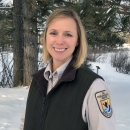This environmental assessment evaluates two action alternatives and a no action alternative. The proposed action would complete structural improvements to a historic shelter known as the Show Pool Shelter at the Seney National Wildlife Refuge. The proposed action would be achieved by taking action to address the purpose and need for action to adverse effects to the shelter occur based on weathering and woodpecker damage to the structure structure
Something temporarily or permanently constructed, built, or placed; and constructed of natural or manufactured parts including, but not limited to, a building, shed, cabin, porch, bridge, walkway, stair steps, sign, landing, platform, dock, rack, fence, telecommunication device, antennae, fish cleaning table, satellite dish/mount, or well head.
Learn more about structure meeting refuge visitor engagement strategies and considering the continued use of the tribal inspired architecture out of respect to tribal nations. The no action alternative would result in continued protection of the shelter by replacing deteriorated materials with in-kind or similar looking materials to ensure the shelter remains structurally sound and that the remaining historic integrity of the building meets the National Register of Historic Places standards.
This environmental assessment examines the potential environmental impacts associated with the proposed action and complies with the National Environmental Policy Act, NEPA, in accordance with the Council on Environmental Quality NEPA regulations (40 Code of Federal Regulations, or CFR, 1500-1508), the Department of the Interior NEPA regulations (43 CFR 46; 516 Department Manual, or DM, 8), U.S. Fish and Wildlife Service policies (550 Service manual, or FW, 3) and other relevant regulations and requirements. NEPA requires examination of the effects of proposed actions on the natural and human environment.
The following resources were analyzed in the environmental assessment: terrestrial wildlife and aquatic species, threatened and endangered species, visitor use and experience, cultural resources, land use on the refuge, administration of the refuge, local and regional economies, and environmental justice (see the Affected Environment and Environmental Consequences section for more information). Several other resources were initially considered by the U.S. Fish and Wildlife Service, including geology and soils, air quality, water quality, habitat and vegetation, floodplains, and wilderness or other special designation, but were ultimately dismissed from further analysis because neither the proposed action nor its alternatives would have the potential to result in measurable impacts to these resources.
Based on the analysis presented in the environmental assessment and coordination and/or consultation with all appropriate federal, state and local agencies as well as all pertinent federally recognized Native American tribes, the U.S. Fish and Wildlife Service has determined that the impacts associated with the proposed action and its alternative would not individually or cumulatively have a significant impact on the quality of the natural and human environment. See Appendix E for Finding of No Significant Impact.
The draft EA was made available for public comment from July 25, 2022 through September 8, 2022 for 45-days. Public comments and agency responses are available in Appendix D of this environmental assessment. Substantive comments are addressed in this final environmental assessment. Any action put forth in this Final Environmental Assessment must meet Section 106 requirements of the National Historic Preservation Act. To meet these requirements consultation with required parties occurred during the Environmental Assessment process. A final determination on action cannot occur without completion of the Section 106 process and as such the decision could not be finalized until a Memorandum of Agreement was developed. Development of this MOA along with additional coordination on threatened and endangered species delayed making a final decision on the selection of an action for this project. A timeline extension pursuant to the National Environmental Policy Act (NEPA), as amended by the Fiscal Responsibility Act of 2023, 42 U.S.C. § 4336a(g)(2) was approved on May 3, 2024 and considered to be the minimum necessary time to complete an environmental assessment given the project details.

